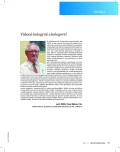Assessing the risk of malnutrition in the elderly- are we using the right screening tool?
Authors:
MUDr. Katarína Bielaková, Ph.D.
Authors‘ workplace:
Klinika interní, geriatrie a praktického lékařství, LF MU a FN Brno
Published in:
Geriatrie a Gerontologie 2018, 7, č. 4: 137-140
Category:
Overview
The risk of malnutrition is increased in elderly patients. Inadequate nutrition contributes to the progression of many diseases, and increase morbidity and mortality, so the early identification and treatment is very important. The aim of the study was to verify the suitability of two types of screening tools to detect the risk of malnutrition in hospitalized seniors. In our study we confirm high risk of malnutrition in hospitalized geriatric patients and MNA-SF test was determined as more sensitive and therefore more suitable for a given type of patients. Patients with a cognitive impairment were identified as a particularly at risk for malnutrition, while a group of patients with intact cognitive function proved to be less risky.
Keywords:
NRS2002 – MNA-SF – nutrition screening tool
Sources
1. Cederholm T, Bosaeus I, Barazzoni R, Bauer J, et al. ESPEN endorsed recommendation.Diagnostic criteria for malnutrition-an ESPEN Consensus Statement. Clin Nutr 2015; 34(3): 335–40.
2. Kubešová H, Weber P, Polcarová V, a kol. Výživa ve stáří. Med pro praxi 2006; 3 : 118–123.
3. Šenkyřík M, Dastych M, Prokešová J. Výživa ve stáří. Geri a gero 2014; 3(4): 175–178.
4. Corish CA, Kennedy NP. Protein-energy undernutrition in hospital in-patients. Br JNutr 2000; 83 : 575–591.
5. Volkert D, Beck AM, Cederholm T, et al. ESPEN guideline on clinical nutrition and hydration in geriatrics. Dostupné: www.espen.org
6. Jurašková B, Hrnčiariková D, Holmerová I, a kol. Poruchy výživy ve stáří. Med pro praxi 2007; 4(11): 443–446.
7. Berková M, Berka Z, Topinková E. Problematika seniorského věku: stařecká křehkost, sarkopenie a disabilita. Practicus 2013; 2 : 13–17.
8. Topinková E. Využití standardizovaných škál pro hodnocení stavu u starších nemocných. Čes ger rev 2003; 1(1): 6–11.
9. Kozáková R, Adamčíková B. Hodnocení stavu výživy hospitalizovaných seniorů na gerontopsychiatrii. Hygiena 2013; 58 (3): 121–124.
10. Pokorná A, Maixnerová L. Sledování nutričního stavu seniorů za hospitalizace. Prakt Lék 2013; 93(5): 221–225.
11. Lera L, Sánches H, Angel B, et al. Mini nutritional assessmement short-form: Validation in five Latin american cities. SABE study. J NutrHealth Aging 2016; 20(8): 797–805.
12. van Bokhorst M, de van der Schueren, Jansma EP. Nutrition screening tools: Does one size fit all? A systematic review of screening tools for the hospital setting. Clin Nutr 2014; 33 : 39–58.
13. Young KW, Greenwood CE. Shift in diurnal feeding patterns in nursing home residents with Alzheimer’s disease. J Gerontol A Biol Sci Med Sci 2001; 56(11): 700–706.
14. Izawa S, Enoki H, Hasegawa J, et al. Factors associated with deterioration of mini nutritional assessment-short form status of nursing home residents during a 2-year period. J Nutr Health Aging 2014; 18(4): 372–377.
15. Martinez M, Gomez-Arnedo L, Alfonso-Silguero S, et al. Nutritional risk, nutritional status and incident disability in older adults. The Fradea Study. J NutrHealthAging 2014; 18(3): 270–276.
Labels
Geriatrics General practitioner for adults Orthopaedic prostheticsArticle was published in
Geriatrics and Gerontology

2018 Issue 4
- Memantine in Dementia Therapy – Current Findings and Possible Future Applications
- Metamizole at a Glance and in Practice – Effective Non-Opioid Analgesic for All Ages
- Metamizole vs. Tramadol in Postoperative Analgesia
- Advances in the Treatment of Myasthenia Gravis on the Horizon
- Hope Awakens with Early Diagnosis of Parkinson's Disease Based on Skin Odor
Most read in this issue
- Vertebral algic syndrom in the elderly
- Urgent lithium intoxication in geriatric patient
- Pleural effusion – an overview of current knowledge
- Assessing the risk of malnutrition in the elderly- are we using the right screening tool?
